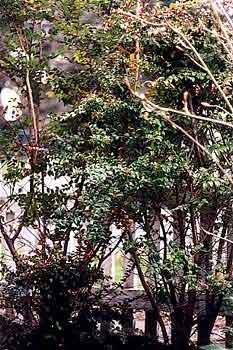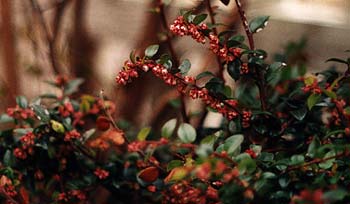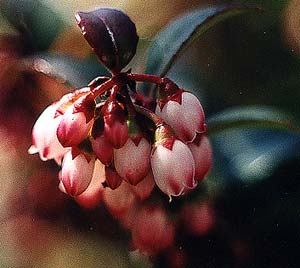 Evergreen Huckleberry:
Evergreen Huckleberry:
the Coastal Northwest's Finest Fruit Shrub
"We're after the same rainbow's end,
waitin' 'round the bend
My huckleberry friend,
Moon River, & me."
-Johnny Mercer
(1909-1976)
(1909-1976)
Where large twiggy broadleaf evergreens like escalonia or huckleberry are concerned, it can be frustrating trying to capture with the camera what my eye sees. I see stunning shrubs, but the camera captures a chaos of formless limbs. I may replace the photos on this Evergreen Huckleberry page whenever I get lucky & the camera finally sees what I'm seeing when I look at our little stand of huckleberry bushes, as it is one of the most beautiful shrubs in the world & I just have to do it better justice eventually.
The above April (2002) photo of our huckleberry bushes shows all three plants. The one on the left is about nine feet tall (its top is cut off in the photo); one is wider & about six feet tall; & a little one in front is only about two feet tall. I added the little one as a kind of fill-in for the bare lower branches of the really tall & gangly specimen. The big twigs poking in from the right are from the Oyama Magnolia.
 In April these bushes develop tiny pink & white flowers as shown in the second photo, not dramatic but quite pleasing. From any distance the shrubs look highlighted in pink & red but it's hard to tell the color is from the blooms rather than new leaves. The third photo (second bloom photo) is an extreme close-up, taken in early May; it's much larger than life size, but captures perfectly what one sees upon closest inspection of the blooming shrubs.
In April these bushes develop tiny pink & white flowers as shown in the second photo, not dramatic but quite pleasing. From any distance the shrubs look highlighted in pink & red but it's hard to tell the color is from the blooms rather than new leaves. The third photo (second bloom photo) is an extreme close-up, taken in early May; it's much larger than life size, but captures perfectly what one sees upon closest inspection of the blooming shrubs.The flowers give way in late spring & summer to tiny green then red huckleberries, which slowly enlarge & ripen to solid black by August & September. Though even at full size they're quite small, these berries are among the tastiest of our native berries. There are 2003 portraits of the fruits on Huckleberry Page of the Berries Gallery, showing them before & after fully ripened.
Many of the edible berries in our yard we frankly leave for the birds, but the huckleberries we harvest. In 2002, two of the three bushes were thick with the berries, & in 2003 all three bushes were heavily fruit-laden. It takes an awfully long time picking these small things to have enough for a huckleberry pie or for jams, but Granny Artemis is way patient about gathering the fruit. Even after a half hour of picking the berries for kitchen use, there is no shortage of berries left on the branches for another go at them later on, as they do not all ripen simultaneously & can be harvested from our garden from late August to mid-October or longer.
 "Huckleberrying" is a tradition of many truly Northwest families, & as a youngster I would go huckleberrying with my Yakama Indian great-grampa on family outings. Granny Artemis, too, remembers huckleberrying in Idaho, & her parents, now retired, still huckleberry regularly. Of the canned jam that results, not a smidgen ever goes to waste.
"Huckleberrying" is a tradition of many truly Northwest families, & as a youngster I would go huckleberrying with my Yakama Indian great-grampa on family outings. Granny Artemis, too, remembers huckleberrying in Idaho, & her parents, now retired, still huckleberry regularly. Of the canned jam that results, not a smidgen ever goes to waste.When grown in shade, evergreen huckleberry shrubs can grow to ten or twelve feet in height. When grown in the sun they remain about three feet high. Our two big ones grew up under a thick forest canopy, before a liscensed collector took them from the wild. In our yard, in late autumn through early spring, they are in an afternoon-sunny location, but with some shade most of the rest of the year, when the nearby cherry tree & the Oyama magnolia are fully leafed.
Although very strongly evergreen, the leaves are replaced at about two-year intervals, & any that are sunburned are apt to be dropped their first winter. The tallest of the three shrubs which gets the most sun (a mite too much) is thus only semi-evergreen, revealing more of its crusty bark & limbs in winter, as shown on the Huckleberry Page along the Winter Bark Garden Walk.
As spring puts leaves on the cherry, the magnolia, & other surrounding shrubs such as a Diablo ninebark, &am a White Icicle Flowering Currant, the huckleberries become increasingly hidden amidst the mini-forest of leaves & branches & flowers. But in winter when the surrounding deciduous shrubs are leafless, the evergreen huckleberries dominate that area by the picket fence, keeping the area lively year-round.